COLOR & CONCEPT IN MY TEXTILE ART -Part 1
BIRD IN PARADISE 1973 to 1976 installation-performance
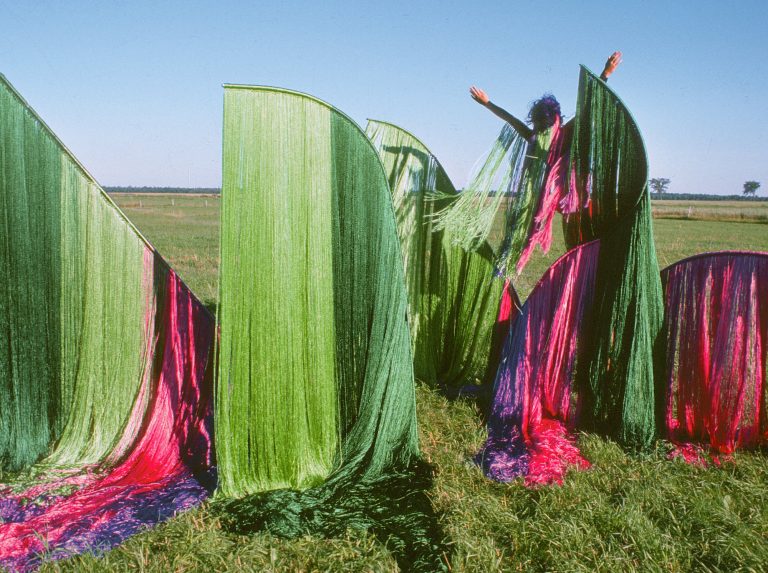
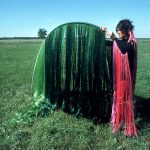
This artwork is composed of 20 panels of acrylic yarn knotted on aluminum tubes. The colors are inspired by the sunlight shining through a prism. Each panel is 244 by 244 cm., and in some cases, the aluminum tube is bent.
Prism as defined by Wikipedia :
“An optical prism is a transparent optical element with flat, polished surfaces that are designed to refract light. ………….
The most familiar type of optical prism is the triangular prism, which has a triangular base and rectangular sides. ………. Prisms can be made from any material that is transparent ….. Typical materials include glass, acrylic and fluorite….. Perceptions associated with a given combination of primary colors can be predicted by an appropriate mixing model (e.g., additive, subtractive) that reflects the physics of how light interacts with physical media, and ultimately the retina. ” (Additive color: Primary colors of light for instance, in a digital image on a computer screen are red, green, blue. Subtractive color : Primary colors of paint & pigments are yellow, magenta, cyan)
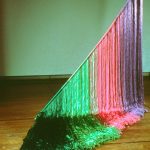
This tapestry titled PRISM is a part of the BIRD IN PARADISE installation, this panel was exhibited at the Museum of Contemporary Art Montreal, 1978, in an exhibition titled “The New Quebec Tapestry”, including 7 other artists. Prism measures: 244 x 244 x 244 cm.
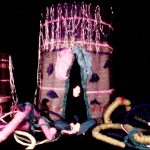
Dream of Earth-Mother is a mixed media installation composed of a woven tapestry in a circular shape. It contains wool and acrylic yarns, ribbons, feathers, sequens and velvet in prism colors. This artwork measures 240 cm high by 365 cm wide by 200 cm deep.
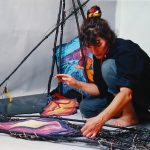
PAULETTE is show working in mixed media, weaving with raffia twine and handmade paper on a frame that she made from tree branches. The colors on the handmade paper are vibrant yellow and red ocher shades with oil pastels, marking a change in her choice of colors, to reflect actual colors found in nature. This is part of a large installation that she exhibited at the Maison de la Culture Cote-des-neiges, in 1984.
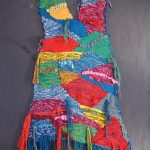
My Funky Dress, woven in 1997 on a rectangular frame, with wool and acrylic yarns, is an homage to my mother who was a couturier and representative for the Nechi-Bernina sewing machine company from around 1955 to 1965. She created magnificent fashions with lovely textures and amazing colors. The dimensions are 152 cm by 92 cm.
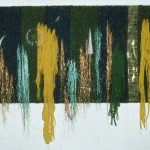
NIGHT ON THE MAIN, created in 1974, is a tapestry woven in wool and acrylic yarns, with glass fiber optics. The tips of the fiber optics light up from a set of fluorescent tubes connected to an electric transformer hidden in a huge wooden box behind the tapestry. The dimensions are -122 cm by 200 cm.
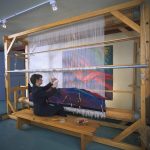
Paulette-Marie Sauve weaving on a high-warp loom, measuring 310 cm wide by 217 cm high. In 1974, Paulette visited the Gobelins Tapestry Company in Paris and was impressed with the huge high-warp looms. She contacted the Nilus Leclerc Company and in 1977, ordered the custom made loom seen in this photo.
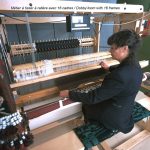
Paulette, in 1998, is weaving on a low-warp style, 16 shaft DOBBY loom that is able to weave electronic designs created on her computer. This loom allows the weaver to use intricate patterns with a huge number of color combinations.
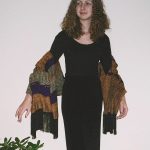
This shawl woven by Paulette in 1998, is modeled by Marie-France. This is woven on the 16 shaft Dobby loom in a very complex weave pattern with Chenille yarns in gold and violet. Paulette selected colors that create a romantic clothing item.
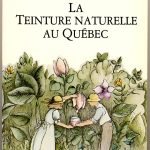
In 1974, while visiting the Gobelins Tapestry Company in Paris, I met Jean Dufour, the master dyer in the very amazing dye studio. He introduced me to ancient dyes, and he used enormous stone vats for preparing indigo dye. He explained the techniques for obtaining permanent, light-fast colors from the natural ingredients. These dyes do not give “Prism” colors, so I changed my color samples to reflect the shades available in natural dyes. I planted a garden of dye plants and wrote down all of my research, and in 1977, I wrote this book (in French) about Natural Dyes that was published by Editions Aurore. It has 138 pages and can be purchased at the boutique of the Museum of Fine Crafts of Quebec (MUMAQ).
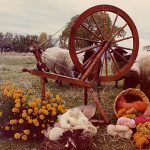
This is the farm where, in 1976, my husband Claude and I began our adventure with raising sheep, spinning wool, and cultivating a garden of dye plants.
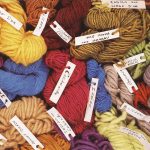
These are skeins of wool from my research in Natural Dyes. For the primary colors, I use either Weld or Golden-rod for yellow, Madder root for an orange red color, or, an insect called Cochineal (imported from Mexico) for crimson red, and Indigo for blue. The secondary colors are obtained by over-dyeing yellow and red to obtain shades of orange, with yellow and blue I get shades of green, with red and blue I get shades of purple. For brown I use imported walnut hulls, and I also import Lichens for a variety of shades such as purple and orange.
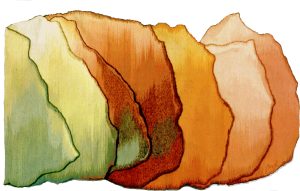
This tapestry is titled MUTATION that I wove in 1984, and the dimensions are 183 by 366 cm.. I sculpted the organic shape directly on a high-warp loom. This artwork was originally woven in seven individual panels that were sewn together in the sequence shown in this photo. It was exhibited at the Museum of Contemporary Art of Montreal in 1984. However, invitations to exhibit this tapestry in museums in other countries such as England, Spain, Norway and Africa, inspired me to weave a visually identical tapestry in only one panel with the same dimensions and the same wool as the original. The warp is cotton seine twine, and the weft is wool that I dyed with natural dyes.